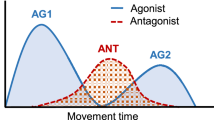Abstract.
In this paper, we propose a model of biological motor control for generation of goal-directed multi-joint arm movements, and study the formation of muscle control inputs and invariant kinematic features of movements. The model has a hierarchical structure that can determine the control inputs for a set of redundant muscles without any inverse computation. Calculation of motor commands is divided into two stages, each of which performs a transformation of motor commands from one coordinate system to another. At the first level, a central controller in the brain accepts instructions from higher centers, which represent the motor goal in the Cartesian space. The controller computes joint equilibrium trajectories and excitation signals according to a minimum effort criterion. At the second level, a neural network in the spinal cord translates the excitation signals and equilibrium trajectories into control commands to three pairs of antagonist muscles which are redundant for a two-joint arm. No inverse computation is required in the determination of individual muscle commands. The minimum effort controller can produce arm movements whose dynamic and kinematic features are similar to those of voluntary arm movements. For fast movements, the hand approaches a target position along a near-straight path with a smooth bell-shaped velocity. The equilibrium trajectories in X and Y show an ‘N’ shape, but the end-point equilibrium path zigzags around the hand path. Joint movements are not always smooth. Joint reversal is found in movements in some directions. The excitation signals have a triphasic (or biphasic) pulse pattern, which leads to stereotyped triphasic (or biphasic) bursts in muscle control inputs, and a dynamically modulated joint stiffness. There is a fixed sequence of muscle activation from proximal muscles to distal muscles. The order is preserved in all movements. For slow movements, it is shown that a constant joint stiffness is necessary to produce a smooth movement with a bell-shaped velocity. Scaled movements can be reproduced by varying the constraints on the maximal level of excitation signals according to the speed of movement.
When the inertial parameters of the arm are altered, movement trajectories can be kept invariant by adjusting the pulse height values, showing the ability to adapt to load changes. These results agree with a wide range of experimental observations on human voluntary movements.
Similar content being viewed by others
Author information
Authors and Affiliations
Additional information
Received: 4 December 1995 / Accepted in revised form: 17 September 1996
Rights and permissions
About this article
Cite this article
Lan, N. Analysis of an optimal control model of multi-joint arm movements. Biol Cybern 76, 107–117 (1997). https://doi.org/10.1007/s004220050325
Issue Date:
DOI: https://doi.org/10.1007/s004220050325




